|
Dr. Ranjana Tiwari Assistant Professor, Bachelor in Management Studies – Tourism & Hospitality Management Jain (Deemed to be University) |
Mr. Amarpreet Singh Student, Bachelor in Management Studies –International Business Jain University |
Keywords: Brand equity, State Bank of India, Aaker Model, Brand image, Brand Loyalty, Brand Preference
The State Bank of India along with its Public sector counterparts has been facing competition from private sector banks since private banks were allowed in 1990 by the Reserve Bank of India. Since that time ICICI Bank and HDFC Bank have gone on to become the two largest private banks in India (Aranca & IBEF, 2018). Since then, the banking industry has adapted to many global changes. Such changes included the introduction of debit cards and net banking along with mobile banking. Along with that the rise of credit card use amongst consumers. The State Bank of India has one the largest base of account holders in India with 22Percent of the market share in the banking industry. Recently, on April 1, 2017, five associate banks of SBI, viz. State Bank of Bikaner & Jaipur, State Bank of Hyderabad, State Bank of Mysore, State Bank of Patiala and State Bank of Travancore, merged with SBI laterally with the Bharatiya Mahila Bank. With the merger, SBI is touted as one of the fifty largest banks in the world. With the State Bank of India previously claiming to be the banker to every Indian, it is necessary to see the recent condition of the brand and the brand equity of State Bank of India after merger. Further, brand equity can be defined as the effects or outcomes of marketing that accumulate to a product with its brand name compared with those that would accumulateif the same product did not have the brand name (Aaker, 1991). Aaker, further described brand equity Brand equity is an amalgam of assets and liabilities which are directly or indirectly linked to a brand, name or its symbol, further, it also adds to or deduct from the value provided by a service or product to the customer of the firm. Along with this Aaker has proposed a model to measure the brand equity value. It is called the Aaker model (Aaker D. A., 1996). The Aaker model has five tangents viz. Brand awareness, Brand association, Perceived Quality, Brand loyalty and other brand related assets. Present research paper aims to research into the brand equity of the State Bank of India as well as find out if a relation exists between Brand equity of a business and loyalty of the customers.
Several researches have pointed out the level of importance of brand equity and its role in the formation of brand loyalty or image. An-Tien Hsieh and Chung-Kai Li (2008) studies the effect of brand image on customer loyalty and public relations perception. The study revealed that loyalty of the customers come after perception of consumers regarding an organisation's PR practice. In the case of favourable brand image, there is stronger and more significant impact of public relations perception (PRP) on customer loyalty. The effect of PRP on customer loyalty is negligible, if it is unfavourable. Ike-Elechi Ogba and Zhenzhen Tan (2009)exploredhow customer loyalty and commitment in the Chinese mobile phone market is getting impacted by the brand image. They concluded that the brand image is very influential to the customer behaviour and their commitment to the brand. Ko de Ruyter and Pascal Peeters, Josee Blooemer (1998) tried to find the factors of bank loyalty: the multifaceted relationship among service quality, image and satisfaction. They said that service quality has an unintended impact on loyalty through satisfaction. Brand image has an impact on satisfaction through service quality perception however brand image does not have an influence on loyalty directly or indirectly. Further they analyzed that whilst brand image has no influence on customer loyalty, the position of the bank has an influence on customer loyalty. Also reliability and efficiency are also important constructs in loyalty to the bank and to the customer satisfaction. Meri Sahramaa (2016)studied the brand image of OP bank and Insurance Company and consumer experience associated with it. The researcher concluded that viewpoints of respondents on the brand image were impacted by the advertising campaigns and the way the media portrays the OP Group. Moreover, the word of mouth and personal experience too influenced the brand image. Yi Zang (2015) examined consumers' attitude and purchase intention by studying the relationship between brand image and brand equity. He found that the awareness of brand and brand image are the foundation of brand equity as well as emotional branding being a very crucial part of brand management. The scholars, Sharareh Momeni, Shabnam Mousavi Khesal, Nasim Roustapisheh, and Mahmood Zohoori (2013)examined the factors influencing brand image in banking industry of Iran. The factors, advertisement (TV, Online and Print) and Service Quality (Tangibles, Reliability, Responsiveness, Assurance, and Empathy) influenced the brand image if the banking industry. The researchers also stressed that the perceived advertisement expenditure is linked with the perception of the brand; therefore a good and interesting advertisement is likely to show the bank as a good quality bank since they can spend so much on their advertisements. Muslim Amin, Zaidi Isa, and Rodrigue Fontaine (2013) studied the factors of level of satisfaction for trust, image and loyalty of Muslim and non-Muslim customers of Islamic banks in Malaysia. The said that customers of religion other than Muslim, of Islamic Banks were more dynamic on their image/perception of the bank with the satisfaction they received from using the services. Muslim customers were tolerant to dissatisfaction a bit more than the non-Muslim customers but at the end satisfaction does play a vital role on the image which both groups have of banks. The results indicated that for both customer segments, significant relationships found between customer satisfaction and image, image and trust, and trust and customer loyalty. The global team of scholars, Hong-Youl Ha, Joby John, SwinderJanda, and Siva Muthaly (2011) examined the
Most of the established researches have used of the SERVQUAL Model (Parasuraman, Berry, & Zeithaml, 1985) or concentrated on the dimension of customer satisfaction or to determine service quality gaps in the banking industry and its players. Therefore, this research is being conducted to be instrumental to and fill the gap of the research into brand equity in India, pertaining to the Indian Banking Sector. This research will possibly lay down more of a direction for future research into the same field. Along with that, this research serves as an indicator on the effectiveness of the State Bank of India's marketing efforts. The research does consider the awareness, perception and association of SBI by the customers and this is shaped by the efforts of the bank in marketing, and so we are able to measure those factors and how positive the results are.
To understand the brand equity of the State Bank of India. To investigate the relationship between customer perception of brand equity and customer loyalty.
The study was conducted in Bangalore city. Business parks, offices and educational institutes were chosen as the places to implement the survey alongside the branches of State Bank of India in Bangalore.
The open and close ended, structured questionnaire was used to record the data from the respondents. The questionnaire divided into three parts. The first recorded the demographic and usage data. The second part had the question related to the components of Aaker's Brand equity model. The third part of the questionnaire asked questions related to the customer's satisfaction with SBI as well as any changes, the customer would like to have happen in SBI. The answer were recorded in Likert scale ranging from 1 being strongly disagree to 5 being strongly agree.
The research study used primary and secondary data. The primary data was collected through structured questionnaire. The sources for secondary data were journals, official website of SBI, and official websites of online news agencies.
The data was collected to through close and open ended, structured questionnaire. The convenient sampling methodwas used to collect the data from the sample.
To analyze the collected data, various statistical techniques and tools such as averages, frequency distribution tables, and normal distribution were used. The study also uses other suitable statistical tools such as mean, median, standard deviation with co-efficient of variation, correlation and regression, factor analysis etc. IBM SPSS 20 software package was used to carry out the various tests
H01: There is no significant relationship between Brand Awareness of SBI and the customer satisfaction
·H02: There is no significant relationship between Brand Association of SBI and the customer satisfaction.
H03: There is no significant relationship between Perceived Quality of SBI and the customer satisfaction.
H04: There is no significant relationship between Brand Loyalty of SBI and the customer satisfaction
H05: There is no significant relationship customer perception of brand equity and customer loyalty.
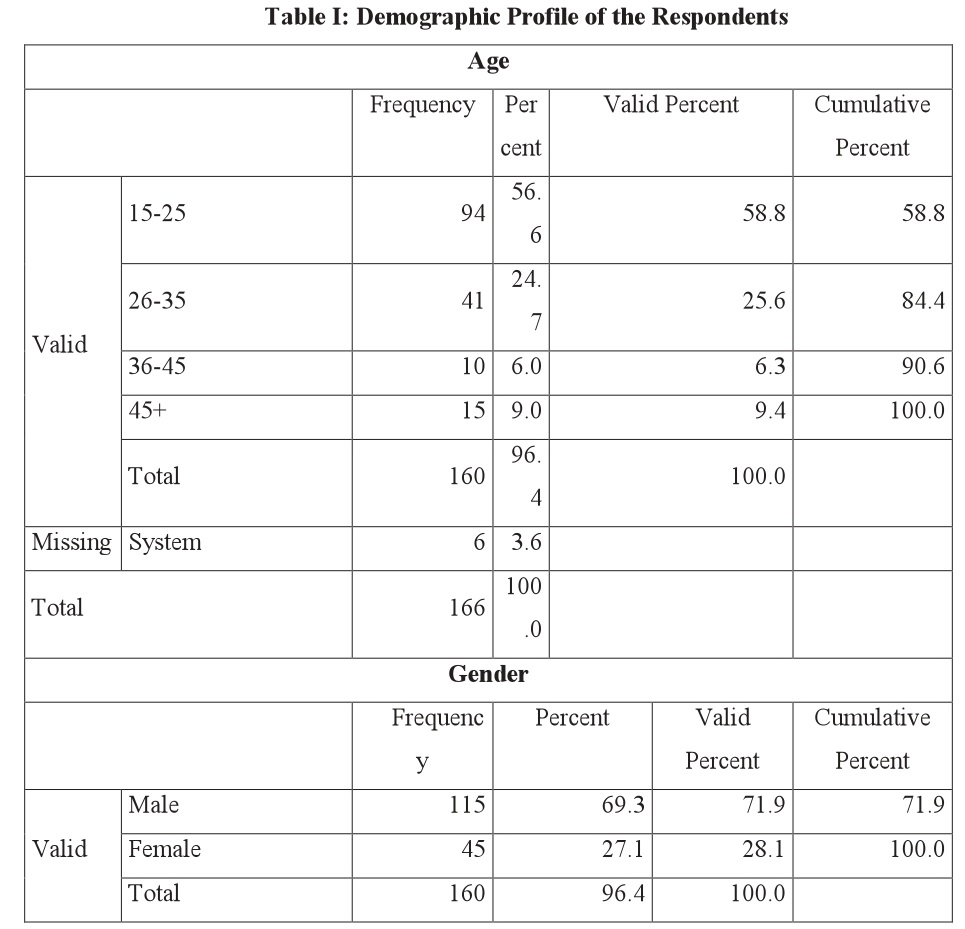
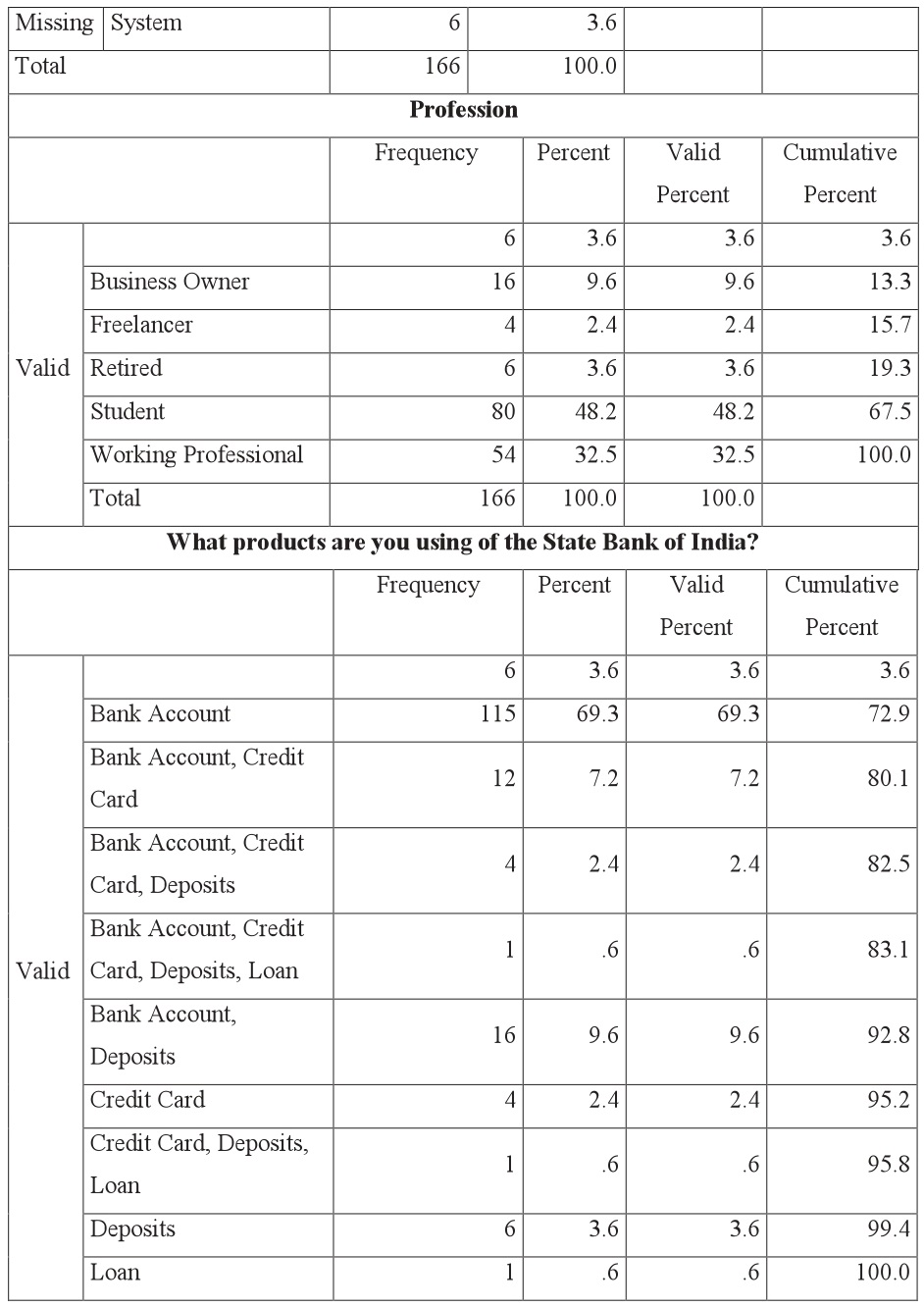
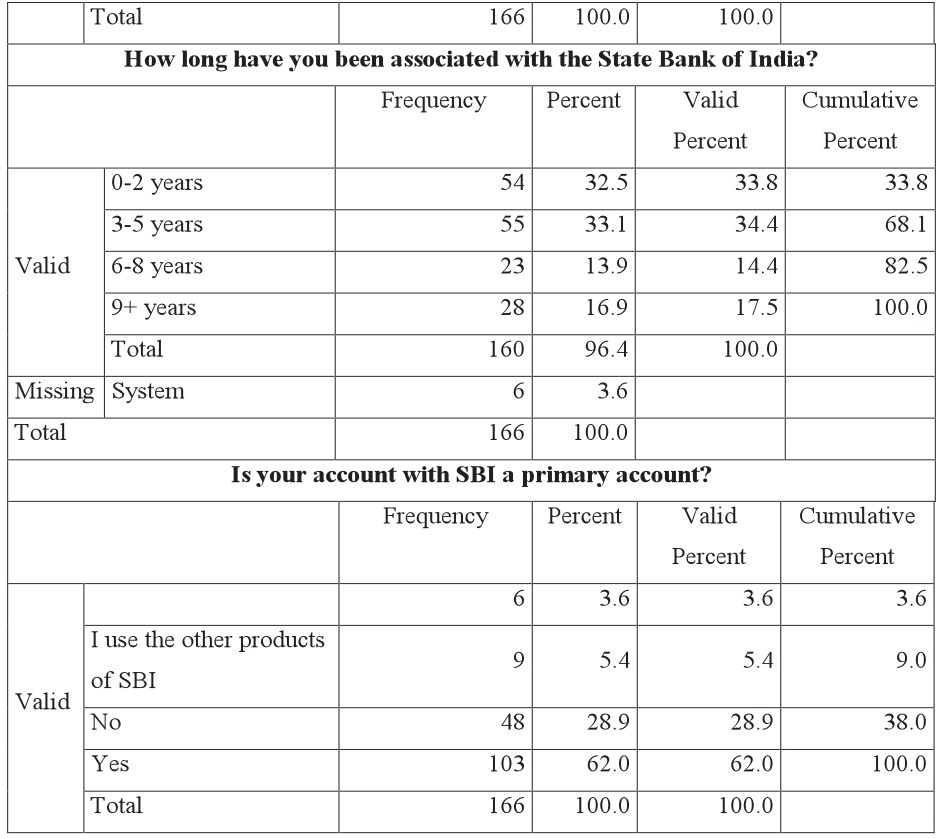
According to Table 1, Majority of the respondents were between the ages of 15-25 followed by the age range of 26- 35.The majority of respondents were Males with 71.88 percent and women accounted for 28.12 percent. Exactly half of the respondents (80) were students followed by working professionals, then business owners, retired persons and freelancers. There were no unemployed persons. Working professionals included shop employees, government staff, MNC employees as well as education institute employees.Almost all of respondents had bank accounts with the State Bank of India. Credit card usage was done by 22 respondents. Deposits were more popular with 28 respondents having a deposit with SBI. Loans only were with 3 respondents. The graph does not show respondents who had selected multiple options. Out of the 160 respondents, 34 were using more than one product of SBI. Almost equal representation is there from customers who have been associated with SBI from 0-2 years and 3-5 years. Therefore majority of the customers have had chosen the State Bank of India in this decade. Many of the customers who have been associated with the State Bank of India for more than 9years were senior citizens as well as pension owners. Another thing to be noted with some of the respondents who have been banking with the State Bank of India for more than 9 years, have done it as their pension comes through SBI only or they have a corporate account with SBI. Over half of the respondents, answered yes to this account being their main account of usage. Along with that, 48 of the respondents did not have their SBI account as their main account, which means they do business with more than one bank. 9 People did not have an account with SBI, and were using other products of SBI.
H01: There is no significant relationship between Brand Awareness of SBI and the customer satisfaction
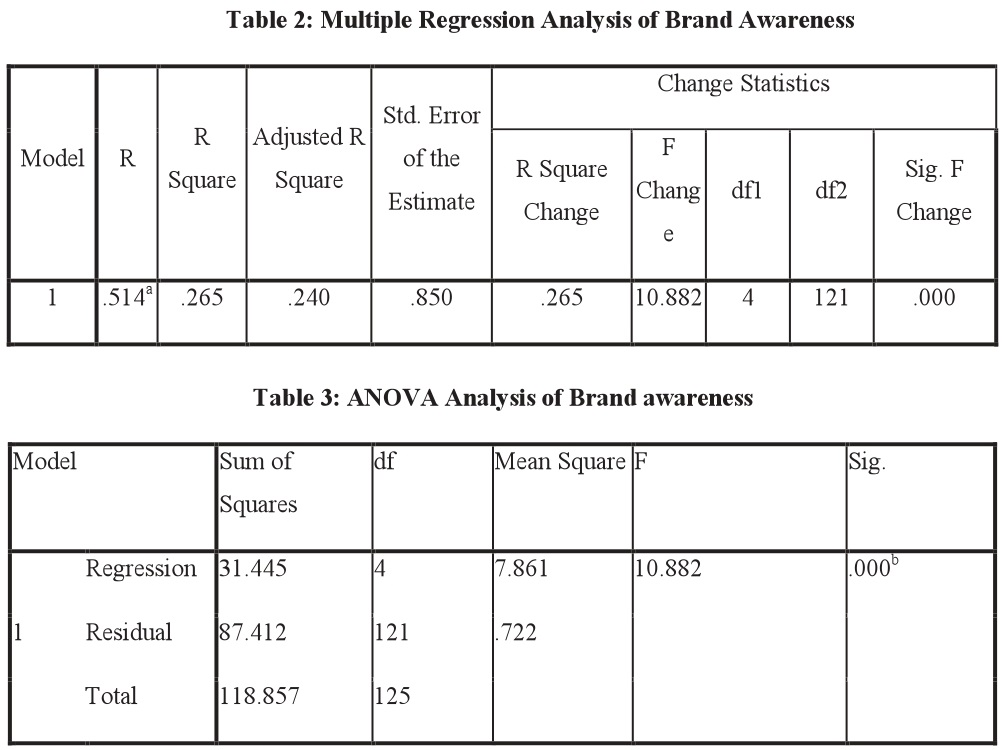
a. Depenent variable:How Satisfied are you with SBI's products and Serviess
Keeping Table 2 and 3 in the view, we can say that since the significance level is less than 0.05 (p=0.000), we reject null hypothesis and accept alternative hypothesis which says that there is a significant association between brand awareness and customer satisfaction. The Adjusted R Square value is 0.240. This means that the two above statements can account for the 24% of the variability. The R value (Multiple Correlation Coefficient) is 0.514 at constant.The first, third and fourth sub variables of the brand awareness variable are more significantly associated with customer satisfaction than the second sub variable.
H02: There is no significant relationship between Brand Association of SBI and the customer satisfaction
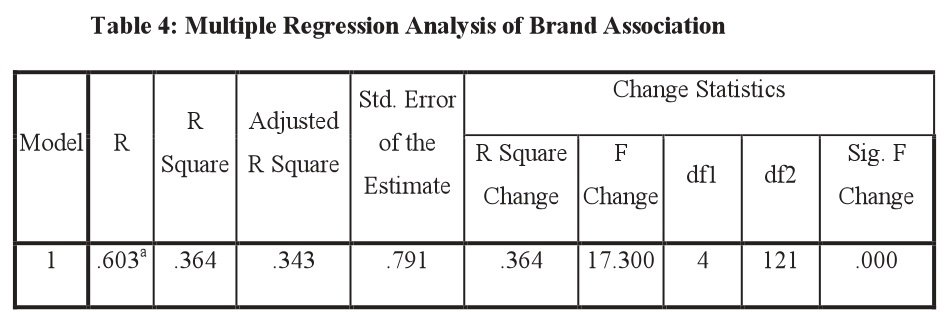
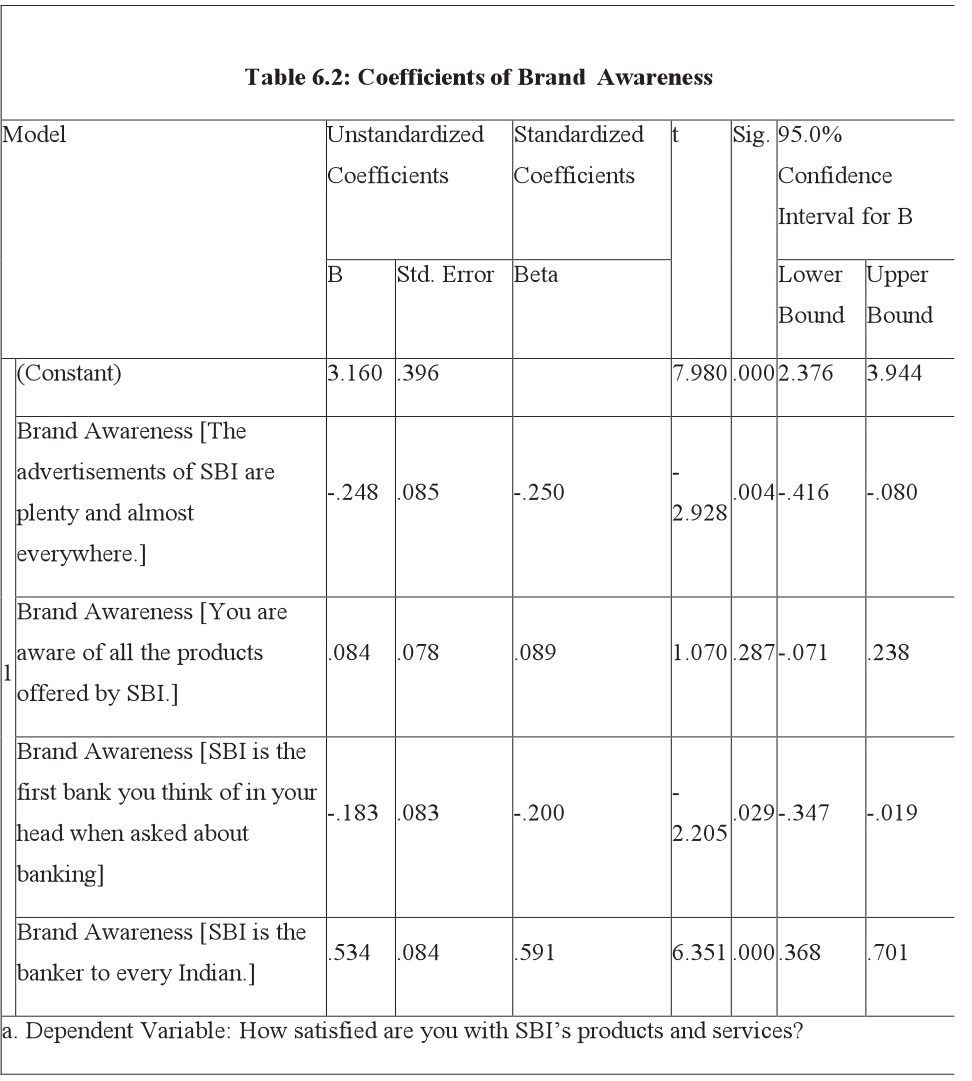
According to Table No. 4 and 5, the significance level is less than 0.05 (p=0.000), therefore, we reject null hypothesis and accept alternative hypothesis which says there is a significant association between brand association and customer satisfaction. The Adjusted R Square value is 0.343. This means that the two above statements can account for the 34.3Percent of the variability. The R value (Multiple Correlation Coefficient) is 0.603 at constant According to Table 6, the first, third and fourth sub variables of the brand association variable are insignificantly associated with customer satisfaction whilst the second sub variable,
H03: There is no significant relationship between Perceived Quality of SBI and the customer satisfaction.
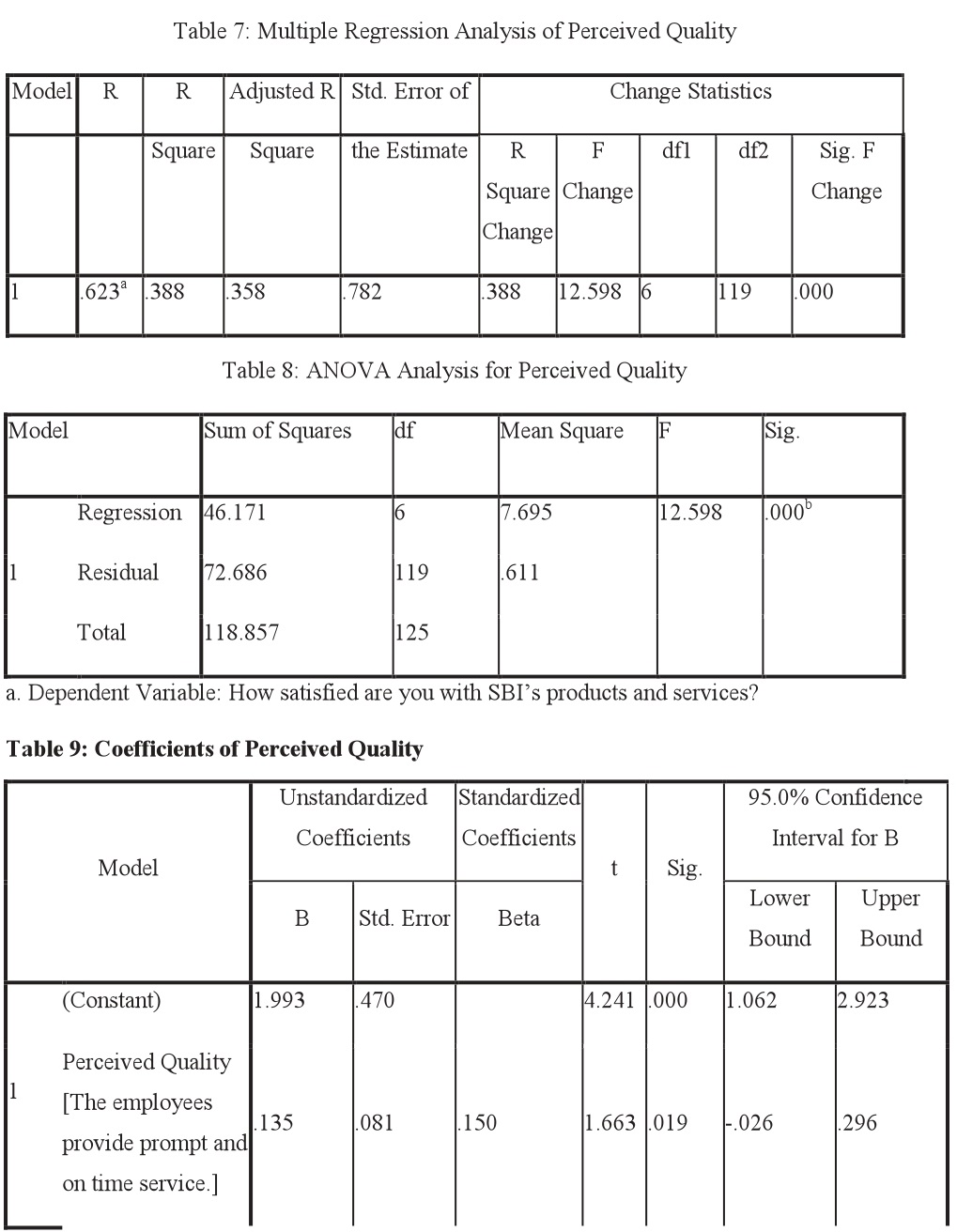
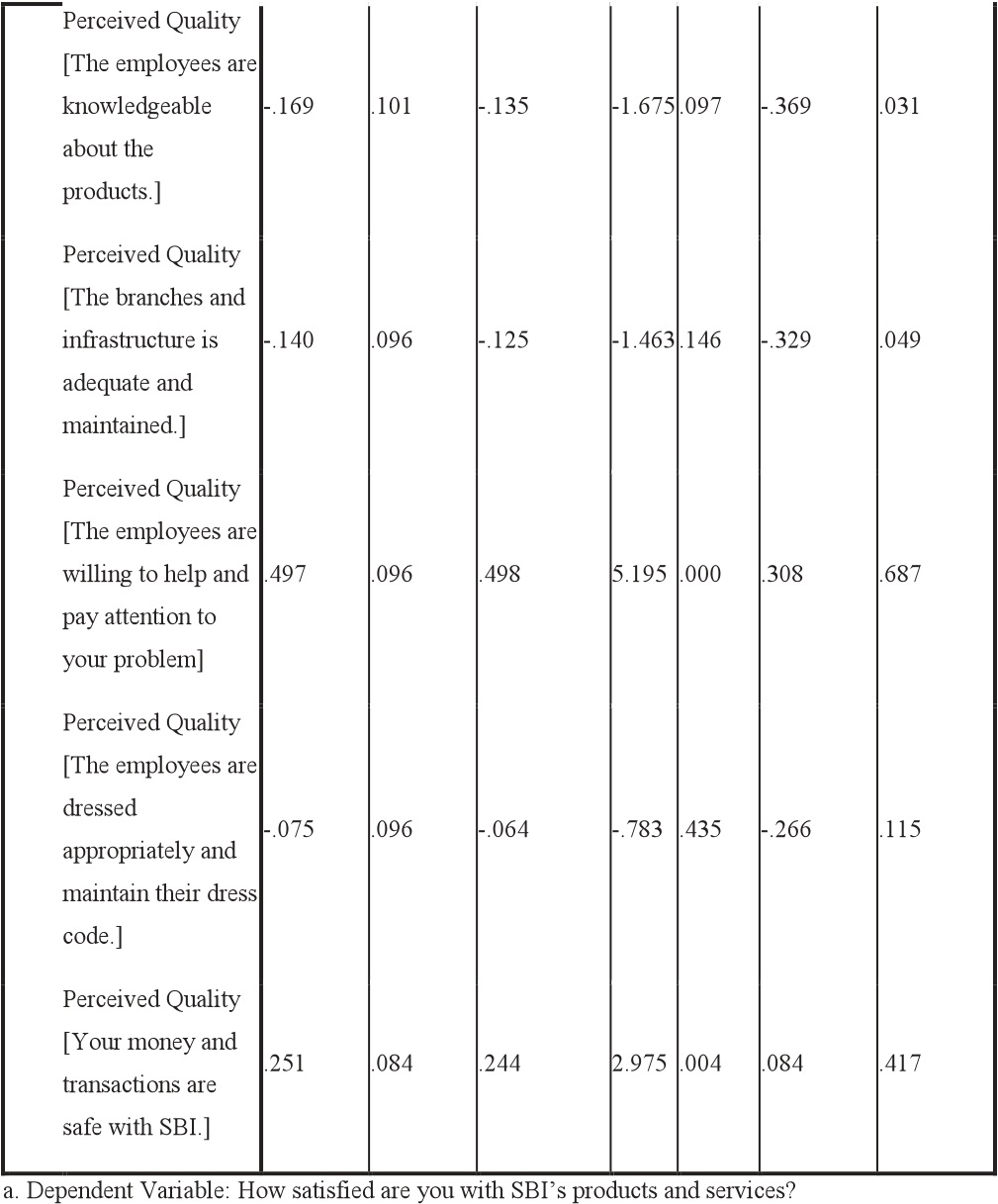
According to Table No. 7 and 8, the significance level is less than 0.05 (p=0.000), hence, we reject null hypothesis and accept alternative hypothesis is at 0.000, this is well below the 0.05 criteria. This means that there is a significant association between the perceived quality and brand awareness and customer satisfaction. The Adjusted R Square value is 0.358. This means that the two above atements can account for the 35.8Percent of the variability. The R value (Multiple Correlation Coefficient) is 0.623 at constant. According to Table No. 9, the first, third and sixth sub variables of perceived quality variable are more significantly associated with customer satisfaction than the other sub variables.
H04: There is no significant relationship between Brand Loyalty of SBI and the customer satisfaction
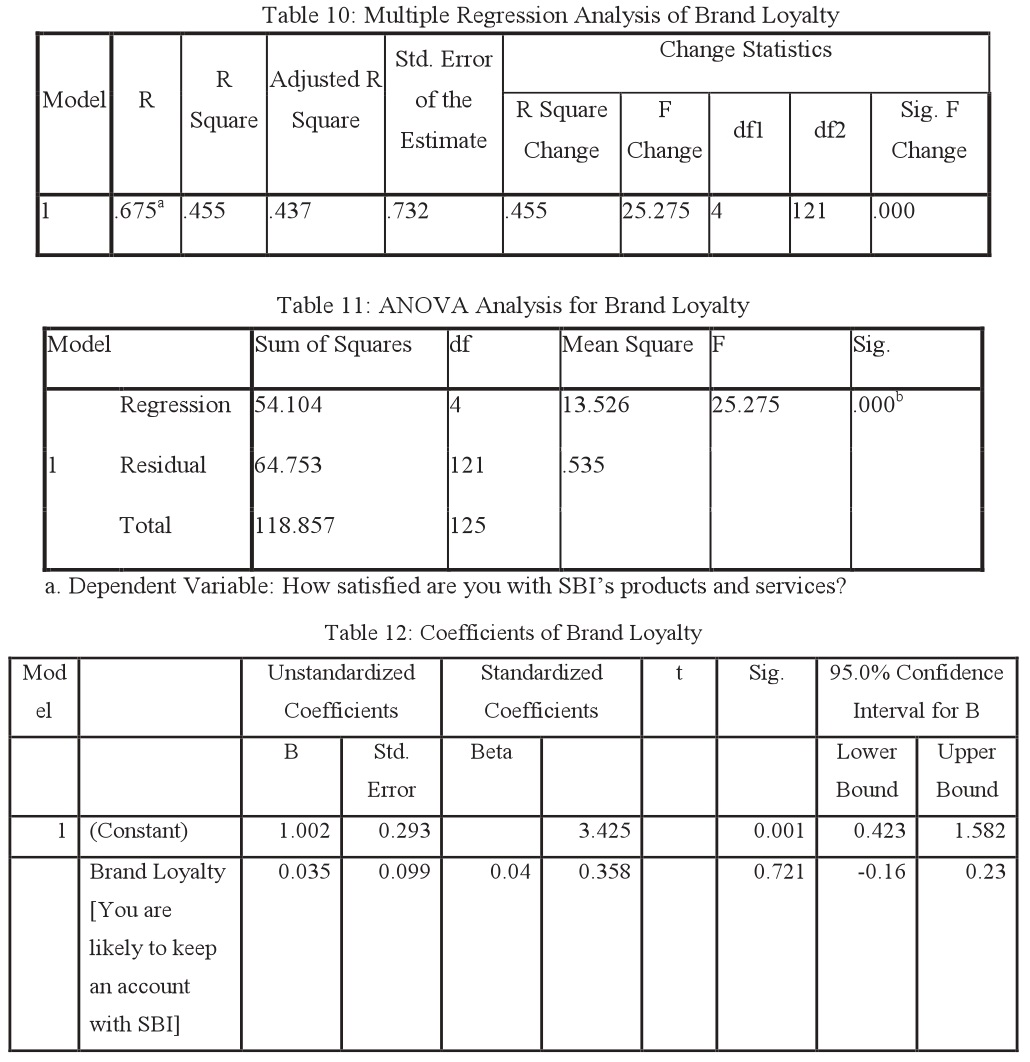
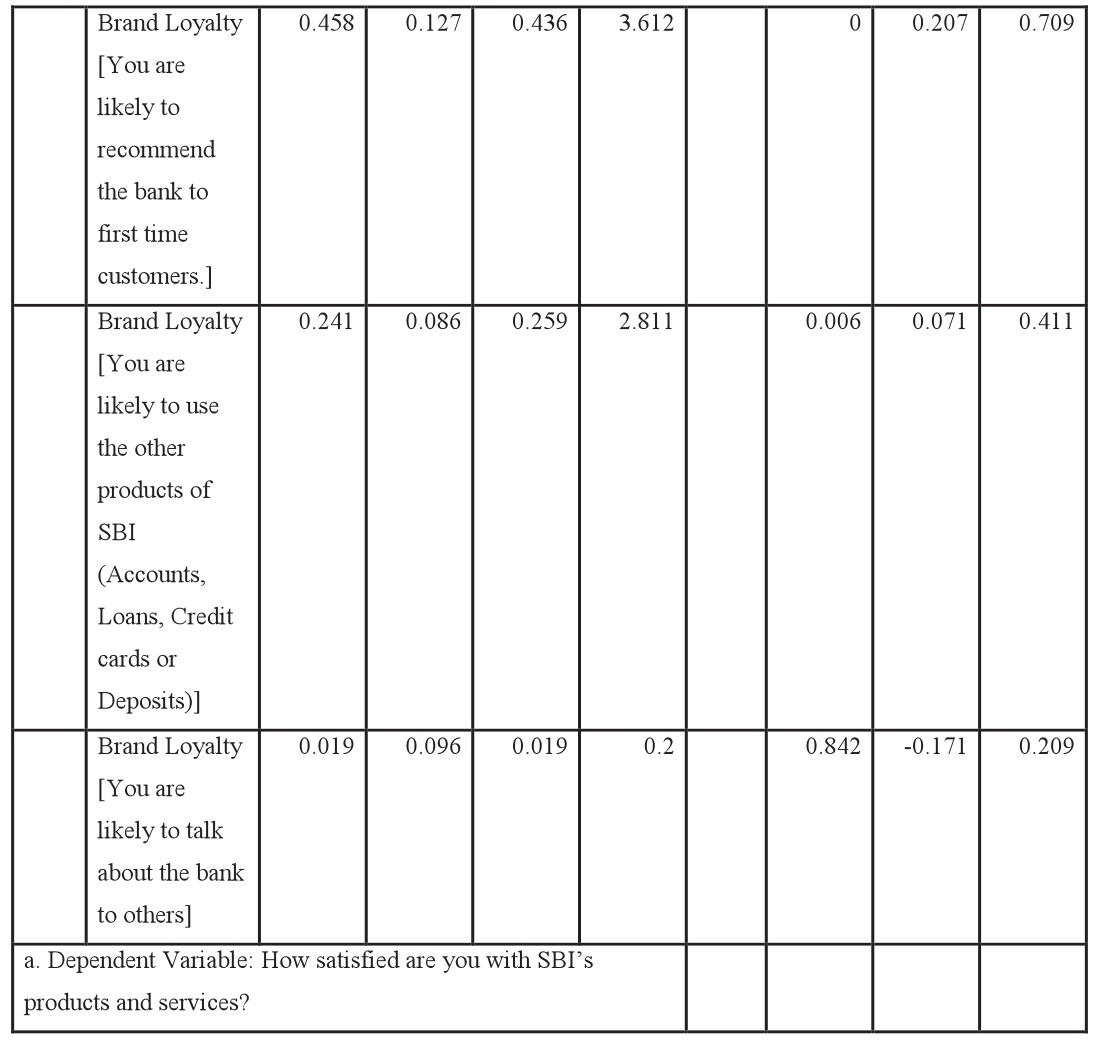
According to Table No. 10 and 11, the significance level is less than 0.05 (p=0.000), therefore, we reject null hypothesis and accept alternative hypothesis is at 0.000, this says that there is a significant association between brand loyalty and customer satisfaction. The Adjusted R Square value is 0.437. This means that the variable can account for the 43.7Percent of the variability in data. According to Table No. 12, the second and third stub variables are the most significant to the overall relationship whilst the first and fourth sub variables have an insignificant relationship with customer satisfaction. This association is supported also by the R value (Multiple Correlation Coefficient). The value is 0.675, which shows a positive relationship with customer satisfaction for Brand Loyalty.
H05: There is no significant relationship customer perception of brand equity and customer loyalty.
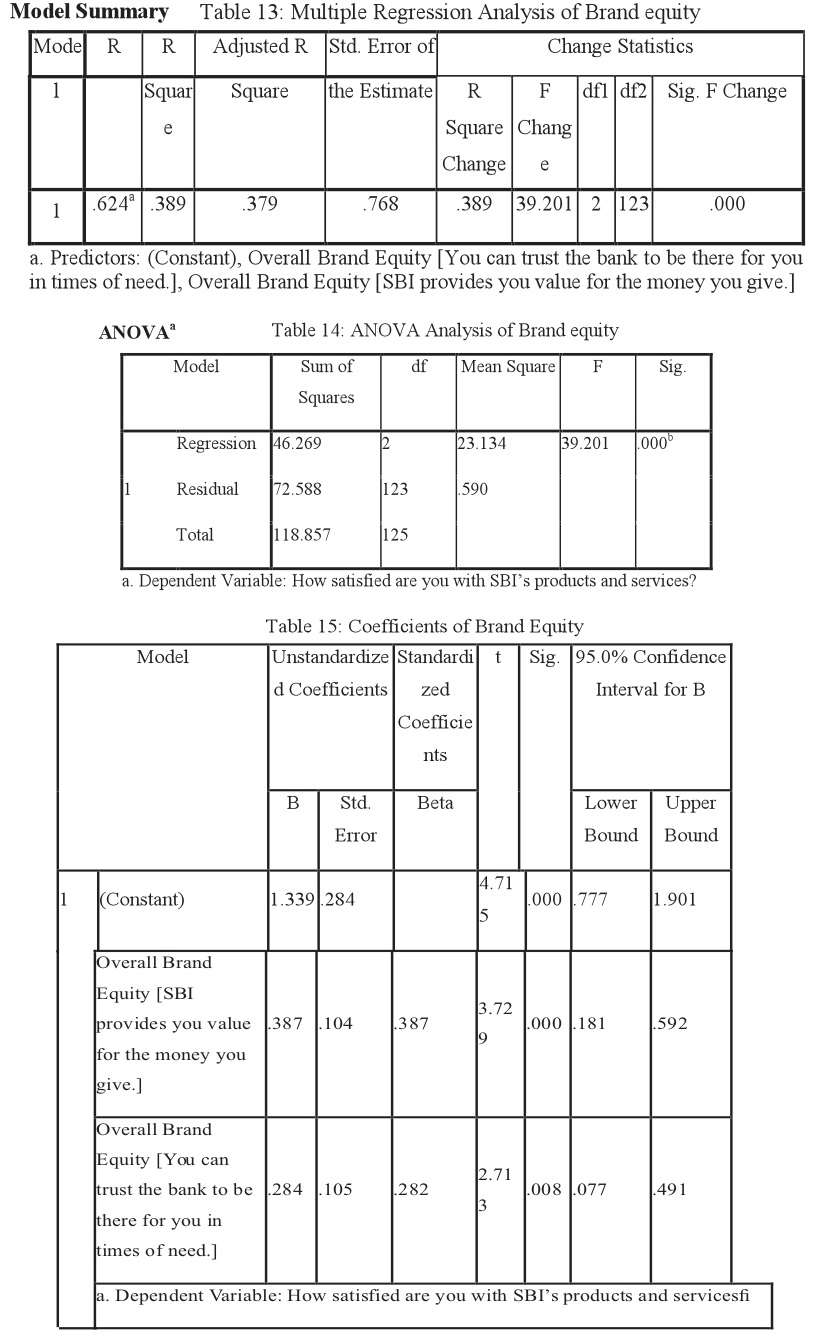
According to Table No. 13 and 14, the significance level is less than 0.05 (p=0.000), henceforth, we reject null hypothesis and accept alternative hypothesis and accept alternate hypothesis which says there is a significant relationship between customer perception of brand equity and customer satisfaction. The Adjusted R Square value is 0.379. This means that the two above statements can account for the 37.9Percent of the variability. The R value (Multiple Correlation Coefficient) is 0.624 at constant.
As per the survey, the key components of the State Bank of India's brand equity were brand awareness, brand association, perceived quality, brand loyalty and overall brand equity. Respondents between the age15-25 were the largest majority at 58.75Percent followed by 26-35 and then respondents above the age of 45. The study revealed that the bank accounts were the most used product of SBI amongst the respondents. Only 34 respondents were using more than one product of SBI. It was also found that within the last 5 years, 67Percent of the respondents had associated themselves with the State Bank of India. Further, a hundred and three people had their account in SBI as their main/primary account. Close to half of the respondents also agreed that the advertisements of SBI are plenty. Moreover, majority of the respondents agreed that SBI is the first bank they think of when banking. The major part of the respondents agreed with SBI's former tagline, SBI, the Banker to Every Indian had greater impact on the customer. Close to half of the respondents agreed with the statement, that SBI provides good customer service. This was followed with over 20Percent disagreeing with the statement. The majority of the respondents also believed that the bank and its employees treated all customers fairly and equally. Exactly half of the respondents believed that the State Bank of India was one of the leaders in the banking industry. Further, in the positive connection to the review of literature, respondents agreed that the employees of SBI (public sector employees) are knowledgeable about the products and services they provide. Majority of the respondents agreed that the infrastructure of the branches is maintained and the employees are willing to help to the customers all the time. Over 75Percent of the respondents vouched in the agreement that that their money is safe with SBI. Further, the majority of the respondents agreed to continue to hold an account with SBI in the future, whilst close to half, would consider using other products of SBI. The respondents were agreed to recommend the bank to first time customers as well as almost half would talk about the bank to others. Over half of the respondents believe that the bank provides value for money in terms of services as well as that they can trust the bank in times of need. Moreover, majority of the respondents were satisfied with SBI but over half of the respondents would like to change something in SBI. Significant relationships were also proved between all the brand equity components and customer satisfaction, independently. Further, the study also revealed that the all components of brand equity of SBI (Brand Awareness, Brand Associations, Perceived Quality, and Brand Loyalty) has the significant association with the customer satisfaction. However, Brand Association plays an imperative part in the formation of brand equity of SBI.
The research into branding and its effects on businesses in India is still quite less but it is slowly increasing. This is especially true for the service industry and consumer goods industry, where branding is more prevalent. The banking sector still has a long way forward to go in terms of research into their branding efforts and its outcomes. Majority of the research into the banking sector of India is primarily focused on the Service quality and uses mainly the SERVQUAL Model (Parasuraman, Berry, & Zeithaml, 1985).This research paper aimed to find out the Association of brand equity of SBI and satisfaction levels of its customers. State Bank of India was chosen as it has the largest market share at 22Percent (The Hindu, 2017) and is one of the leading public sector banks. With one hundred and sixty respondents chosen randomly and conveniently, the analysis showed that brand equity does exist and that too positive for the State Bank of India. Most respondents had a positive response to the variables provided in the survey instrument. This can be considered as the marketing efforts of SBI being effective in reaping a positive image for the bank amongst the public and effectively achieving their marketing objectives. The study shows that the Brand Awareness component of the Brand equity model has a slightly weaker relationship to the customer satisfaction levels of the customers compared to the relationships of other brand equity components and their relationships with the customer satisfaction levels. Therefore, it is recommended to State Bank of India, to focus on that aspect and primarily to the working population and the student customer segment as our research found most of the respondents are below the age of 35.Overall, the branding outcome for the State Bank of India is positive and effective. The way the State Bank of India is associated is not negative. However, the State Bank of India can work on improving the reach of its advertisements as well as customer service.
Lack of previously established research on brand equity in the Indian Banking Industry, makes very difficult to find a direction with ease.
Unequal representation of both genders. Men and women are represented approximately at 70-30 percentage respectively.
Denial of access to customers within multiple State Bank of India branches.
Survey Instrument only available in one language. It did not allow tapping into more of the region's native population.
Aaker, A. D. (1991). Managing Brand Equity. Free Press.
Aaker, D. A. (1996). Building Strong Brands. Free Press.
Aranca & IBEF. (2018, February 1). Sectoral ReportRetrieved March 7, 2018, from www.ibef.com: https://www.ibef.org/download/Banking- February-20181.pdf
Atilgan, E., Aksoy, S., & Akinci, S. (2005). Determinants of the brand equity: A verification approach in the beverage industry in Turkey. Marketing Intelligence & Planning , 237-248.
Banerjee, N., & Sah, S. (2012). A Comparative Study of Customers' Perceptions of Service Quality Dimensions between Public and Private Banks in India. International Journal of Business Administration .
Bapat, D. (2010). Perceptions on Banking Service in Rural India: An Empirical Study. International Journal of Rural Management .
Berry, L. L. (2000). Cultivating Service Brand Equity. Journal of the Academy of Marketing Science , 29.
Blooemer, J., Ruyter, K. d., & Peeters, P. (1998). Investigating drivers of bank loyalty: the complex relationship between image, service quality and satisfaction. International Journal of Bank Marketing , 276-287.
Coca Cola. (n.d.). Coca Cola Fun Facts. Retrieved March 6, Grover, R., & Srinivasan, V. (1992). Evaluating the Multiple Effects of Retail Promotions on Brand Loyal and Brand Switching Segments. Journal of Marketing Research , 14.
Ha, H. Y., Janda, S., & Muthaly, S. (2011). The effects of advertising spending on brand loyalty in services. European Journal of Marketing , 673-691.
Hsieh, A.-T., & Li, C. K. (2008). The moderating effect of brand image on public relations perception and customer loyalty. Taiwan: Emerald Group Publishing Limited.
Isa, Z., Amin, M., & Fontaine, R. (2013). Islamic Banks: Contrasting the drivers of customer satisfaction, image, trust, and loyalty of Muslim and Non- Muslim customers in Malaysia. International Journal of Bank Marketing , 79-97.
James, D. (2005). Guilty through association: Brand association transfer to brand alliances. Journal of Consumer Marketing , 14-24.
Karthik, M. (2017, March 30). Air India SBI Signature Card Review. Retrieved March 8, 2018, from Mani Karthik Blog: https://news.manikarthik.com/air- india-sbi-signature-card-review/money/
Kathuria, L. M., & Bassan, L. (2016). Understanding dimensions of customer-based brand equity in banks. International Journal of Business Competition and Growth. , 21-33.
Keller, K. L. (1998). Strategic Brand Management: Building, Measuring, and Managing Brand Equity. Upper Saddle River: Prentice Hall.
Knox, S., & Freeman, C. (2006). Measuring and Managing Employer Brand Image in the Service Industry. Journal of Marketing Management , 695-716.
Malik, G. (2012). A comparative study on the service quality and customer satisfaction among private and public banks in India. Pacific Business Review , 51-64.
Meri, S. (2016). Consumer experience on the brand image of OP bank and Insurance Company. Arcada.2018, from Coca Cola UK: http://www.cocacola.co.uk/stories/coca-cola-fun-factsinfographic#
Gangopadhyay, P. (2015). Customer perception of brand Ogba, I. E., & Tan, Z. (2009). Exploring the impact of brand image on customer loyalty and commitment in China. Journal of Technology Management in China , 132-144.
Oliver, R. L. (1997). Satisfaction: A Behavioural Perspective on the Consumer. New York: McGraw Hill.
Oxford Dictionary. (n.d.). Brand. Retrieved March 7, 2018, from Oxford Dictionary: https://en. oxforddictionaries. com/definition/ brand
Parasuraman, A., Berry, L. L., & Zeithaml, V. A. (1985). A Conceptual Model of Service Quality and Its Implications For Future Research. Journal of Marketing , 41-50.
Percy, L., & Rossiter, J. R. (1992). A model of brand awareness and brand attitude advertising strategies. Psychology and Marketing , 263-274.
Pinterest. (n.d.). Brand Equity Model. Retrieved March 7, 2018, from Pinterest.
Reserve Bank of India Bangalore office. (n.d.). Retrieved March 7, 2018, from Reserve Bank of India: https://rbi.org.in/regionalbranch/bangalore/banga lore.aspx
Simer. (2017, April 7). SBI merger: Boon or Bane for India? Retrieved March 7, 2018, from Simer – The M & A c r i t i c ( Wo r d P r e s s B l o g ) : https://simerkukreja. wordpress.com /2017/04/07/0sbi-merger-boon-or-bane-for-india/ State Bank of India Local Head Office Bangalore. (n.d.).
Momeni, S., Khesal, S. M., Roustapisheh, N., & Zohoori, M. (2013). Factors Influencing Brand Image in Banking Industry of Iran. Interdisciplinary Journal of Contemporary Research in Business , 7. Retrieved March 7, 2018, from Mapio: http://mapio.net/pic/p-14259584/
State Bank of India. (2017, September 15). Twitter Account of the State Bank of India. Retrieved March 7, 2018, from Twitter: https://twitter.com/ theofficialsbi/ status/ 908672603694489601
theofficialsbi/ status/ 908672603694489601 Stokes, R. (1985). The Effects of Price, Package Design, and Brand Familiarity on Perceived Quality. Journal of Economic Psychology .
The Hindu. (2017, March 5). When SBI, associate banks merge. Retrieved March 6, 2018, from The Hindu: Retrieved from http://www.thehindu.com/ business/Industry/when-sbi-associate-banks- merge/ article17410334.ece
Yoo, B., Donthu, N., & Lee, S. (2000). An examination of selected marketing mix elements and brand equity. Journal of the Academy of Marketing Science , 195-211.
Zeithaml, V. A. (1988). Consumer Perceptions of Price, Quality, and Value: A Means-End Model and Synthesis of Evidence. Journal of Marketing , 22. Zhang, Y. (2015). The Impact of Brand Image on Consumer Behavior: A Literature Review. Open Journal of Business and Management , 58-62.